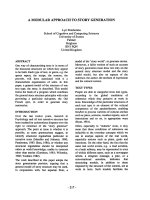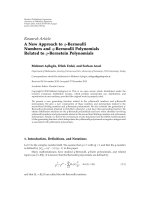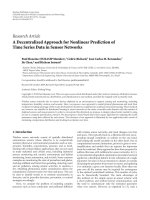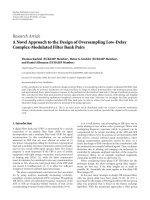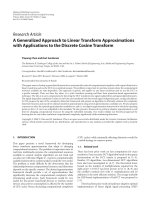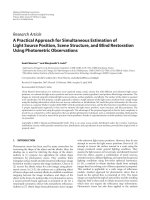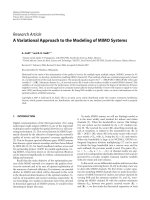(EBOOK) research methods a modular approach
Bạn đang xem bản rút gọn của tài liệu. Xem và tải ngay bản đầy đủ của tài liệu tại đây (5.38 MB, 466 trang )
SECOND EDITION
Research Methods
A Modular Approach
Sherri L. Jackson
Jacksonville University
Australia • Brazil • Japan • Korea • Mexico • Singapore • Spain • United Kingdom • United States
Copyright 2010 Cengage Learning, All Rights Reserved. May not be copied, scanned, or duplicated, in whole or in part.
This is an electronic version of the print textbook. Due to electronic rights
restrictions, some third party content may be suppressed. Editorial
review has deemed that any suppressed content does not materially
affect the overall learning experience. The publisher reserves the
right to remove content from this title at any time if subsequent
rights restrictions require it. For valuable information on pricing, previous
editions, changes to current editions, and alternate formats, please visit
www.cengage.com/highered to search by ISBN#, author, title, or keyword
for materials in your areas of interest.
Copyright 2010 Cengage Learning, All Rights Reserved. May not be copied, scanned, or duplicated, in whole or in part.
Research Methods: A Modular Approach,
Second Edition
Sherri L. Jackson
© 2011, 2008 Wadsworth/Cengage Learning
ALL RIGHTS RESERVED. No part of this work covered by the copyright
hereon may be reproduced or used in any form or by any means—graphic,
Publisher: Linda Schreiber-Ganster
electronic, or mechanical, including photocopying, recording, taping, Web
Acquisitions Editor: Tim Matray
distribution, information storage and retrieval systems, or in any other
Editorial Assistant: Alicia McLaughlin
manner—without the written permission of the publisher.
Production Technology Analyst: Lori Johnson
Senior Marketing Manager: Jessica Egbert
Manufacturing Director: Marcia Locke
Media Editor: Mary Noel
Senior Marketing Communications Manager:
Talia Wise
For product information and technology assistance, contact us at
Cengage Learning Customer & Sales Support, 1-800-354-9706.
For permission to use material from this text or product, submit all
requests online at cengage.com/permissions.
Further permissions questions can be emailed to
Content Project Manager: Pre-PressPMG
Senior Art Director: Vernon Boes
Library of Congress Control Number: 2010925784
Print Buyer: Linda Hsu
ISBN-13: 978-0-495-81119-0
Rights Specialist/Text: Roberta Broyer
Rights Specialist/Image: Dean Dauphinais
Production Service: Pre-PressPMG
Cover Designer: Denise Davidson
Cover Photo: DK & Dennie Cody/Masterfile
Compositor: Pre-PressPMG
ISBN-10: 0-495-81119-X
Wadsworth
20 Davis Drive
Belmont, CA 94002-3098
USA
Printer: RR Donnelley
Cengage Learning is a leading provider of customized learning solutions
with office locations around the globe, including Singapore, the United
Kingdom, Australia, Mexico, Brazil, and Japan. Locate your local office at
www.cengage.com/global.
Cengage Learning products are represented in Canada by
Nelson Education, Ltd.
To learn more about Wadsworth, visit www.cengage.com/Wadsworth.
Purchase any of our products at your local college store or at our
preferred online store www.CengageBrain.com.
Printed in the United States of America
1 2 3 4 5 6 7 14 13 12 11 10
Copyright 2010 Cengage Learning, All Rights Reserved. May not be copied, scanned, or duplicated, in whole or in part.
To my parents, Kenneth and Eleanor,
for all they have done
Copyright 2010 Cengage Learning, All Rights Reserved. May not be copied, scanned, or duplicated, in whole or in part.
ABOUT THE AUTHOR
SHERRI L. JACKSON is Professor of Psychology at
Jacksonville University, where she has taught since
1988. At JU she has won the Excellence in Scholarship
(2003), University Service (2004), and Teaching
Awards (2009), the university-wide Professor of the
Year Award (2004), the Woman of the Year Award
(2005), and the Institutional Excellence Award (2007).
She received her M.S. and Ph.D. in cognitive/experimental
psychology from the University of Florida. Her research interests include human reasoning and the teaching of psychology. She has published numerous articles
in both areas. In 1997 she received a research grant
from the Office of Teaching Resources in Psychology
(APA Division 2) to develop A Compendium of
Introductory Psychology Textbooks 1997–2000. She is
also the author of Research Methods and Statistics:
A Critical Thinking Approach, 3rd edition (Belmont,
CA: Wadsworth/Cengage, 2009) and Statistics Plain
and Simple, 2nd edition (Belmont, CA: Wadsworth/
Cengage, 2010).
iv
Copyright 2010 Cengage Learning, All Rights Reserved. May not be copied, scanned, or duplicated, in whole or in part.
BRIEF CONTENTS
PREF AC E
CHAPTER
xxi
1 Thinking Like a Scientist
1
Module
1
Science and Psychology 3
Module
2
An Introduction to Research Methods 19
CHAPTER
2 Getting Started
33
Module
3
Research Ideas 35
Module
4
Ethical Research 46
CHAPTER
3 Variables
67
Module
5
Defining, Measuring, and Manipulating Variables 69
Module
6
Reliability and Validity 80
v
Copyright 2010 Cengage Learning, All Rights Reserved. May not be copied, scanned, or duplicated, in whole or in part.
vi
BRIEF CONTENTS
CHAPTER
4 Descriptive Methods
93
Module
7
Observational and Qualitative Methods 95
Module
8
Survey Methods 109
CHAPTER
Module
5 Predictive (Relational) Methods
9
127
Conducting Correlational Research 130
Module
10
Quasi-Experimental Designs 143
Module
11
Conducting Single-Case Research 155
CHAPTER
6 Explanatory Methods
169
Module
12
Between-Participants Experimental Designs 172
Module
13
Correlated-Groups and Developmental Designs 186
Module
14
Advanced Experimental Designs 195
CHAPTER
7 Descriptive Statistics
213
Module
15
Data Organization, Central Tendency, and Variance 215
Module
16
Transformation Scores and Correlation Coefficients 233
CHAPTER
8 Inferential Statistics I
259
Module
17
Hypothesis Testing 261
Module
18
The t Test for Independent Groups 270
Copyright 2010 Cengage Learning, All Rights Reserved. May not be copied, scanned, or duplicated, in whole or in part.
BRIEF CONTENTS
CHAPTER
9 Inferential Statistics II
285
Module
19
t Test for Correlated Groups (Samples) 287
Module
20
Analysis of Variance (ANOVA) 296
CHAPTER
10 APA Communication Guidelines
319
Module
21
Communicating Research Findings 321
Module
22
APA Sample Manuscript 337
APPENDIX
A Answers to Odd-Numbered Exercises 355
APPENDIX
B Statistical Tables 371
APPENDIX
C Excel, SPSS, and TI84 Exercises 386
APPENDIX
D Computational Formulas for ANOVAs 426
REFERENCES 427
GLOSSARY 429
INDEX 435
Copyright 2010 Cengage Learning, All Rights Reserved. May not be copied, scanned, or duplicated, in whole or in part.
vii
CONTENTS
PREF ACE
CHAPTER
Module
xxi
1 Thinking Like a Scientist
1
1
Science and Psychology 3
Areas of Psychological Research
Psychobiology 6
Cognition 6
Human Development 6
Social Psychology 6
Psychotherapy 8
Sources of Knowledge 8
Superstition and Intuition
Authority 9
Tenacity 9
Rationalism 10
Empiricism 10
Science 11
6
8
The Scientific (Critical Thinking) Approach and Psychology
Systematic Empiricism 12
Public Verification 13
Empirically Solvable Problems
Basic and Applied Research
Goals of Science 16
12
13
15
Description 16
Prediction 16
Explanation 16
Summary
17
viii
Copyright 2010 Cengage Learning, All Rights Reserved. May not be copied, scanned, or duplicated, in whole or in part.
CONTENTS
Review of Key Terms 17
Module Exercises 17
Critical Thinking Check Answers
Web Resources 18
Module
2
18
An Introduction to Research Methods 19
Descriptive Methods 20
Predictive (Relational) Methods 21
Explanatory Method 22
Doing Science 25
Proof and Disproof 26
The Research Process 27
Summary 27
Review of Key Terms 27
Module Exercises 28
Critical Thinking Check Answers 29
Web Resources 29
CHAPTER ONE SUMMARY AND REVIEW: THINKING LIKE
A SCIENTIST 30
CHAPTER
Module
2 Getting Started
3
33
Research Ideas 35
Reviewing the Literature
Library Research 37
37
Journals 37
Psychological Abstracts 38
PsycINFO and PsycLIT 38
Social Science Citation Index and Science Citation Index
Other Resources 42
42
Reading a Journal Article: What to Expect 44
Abstract 44
Introduction 44
Method 45
Results 45
Discussion 45
Summary 45
Module Exercise 45
Web Resources 45
Copyright 2010 Cengage Learning, All Rights Reserved. May not be copied, scanned, or duplicated, in whole or in part.
ix
x
CONTENTS
Module
4
Ethical Research 46
Ethical Standards in Research with Human Participants
Institutional Review Boards
Informed Consent 54
Risk 55
Deception 57
Debriefing 57
54
Ethical Standards in Research with Children
Ethical Standards in Research with Animals
Summary 63
Review of Key Terms 63
Module Exercises 63
Critical Thinking Check Answers
Web Resources 64
47
57
58
63
CHAPTER TWO SUMMARY AND REVIEW: GETTING STARTED 65
CHAPTER
Module
3 Variables
5
67
Defining, Measuring, and Manipulating Variables 69
Defining Variables 70
Properties of Measurement 71
Scales of Measurement 71
Nominal Scale 72
Ordinal Scale 72
Interval Scale 72
Ratio Scale 73
Discrete and Continuous Variables 74
Types of Measures 74
Self-Report Measures 74
Tests 75
Behavioral Measures 75
Physical Measures 76
Summary 77
Review of Key Terms 78
Module Exercises 78
Critical Thinking Check Answers
Web Resources 79
78
Copyright 2010 Cengage Learning, All Rights Reserved. May not be copied, scanned, or duplicated, in whole or in part.
CONTENTS
Module
6
Reliability and Validity 80
Reliability
81
Error in Measurement 81
How to Measure Reliability: Correlation Coefficients
Types of Reliability 83
Test/Retest Reliability 83
Alternate-Forms Reliability 83
Split-Half Reliability 84
Interrater Reliability 84
Validity
82
85
Content Validity 85
Criterion Validity 86
Construct Validity 86
The Relationship between Reliability and Validity
Summary 88
Review of Key Terms 88
Module Exercises 88
Critical Thinking Check Answers
Web Resources 89
87
89
CHAPTER THREE SUMMARY AND REVIEW: VARIABLES 90
CHAPTER
Module
4 Descriptive Methods
7
93
Observational and Qualitative Methods 95
Naturalistic Observation 96
Options When Using Observation 96
Laboratory Observation 98
Data Collection 99
Narrative Records
Checklists 100
99
Qualitative Methods 101
Case Study Method 102
Archival Method 102
Interviews and Focus Group Interviews
Field Studies 104
Action Research 105
Qualitative Data Analysis 106
103
Summary 106
Review of Key Terms 107
Copyright 2010 Cengage Learning, All Rights Reserved. May not be copied, scanned, or duplicated, in whole or in part.
xi
xii
CONTENTS
Module Exercises 107
Critical Thinking Check Answers
Web Resources 108
Lab Resources 108
Module
8
107
Survey Methods 109
Survey Construction
110
Writing the Questions 110
Arranging the Questions 113
Administering the Survey
Mail Surveys 113
Telephone Surveys 115
Personal Interviews 116
113
Sampling Techniques 117
Probability Sampling 117
Nonprobability Sampling 119
Summary 121
Review of Key Terms 121
Module Exercises 121
Critical Thinking Check Answers
Web Resources 122
Lab Resources 122
121
CHAPTER FOUR SUMMARY AND REVIEW: DESCRIPTIVE
METHODS 123
CHAPTER
Module
5 Predictive (Relational) Methods
9
127
Conducting Correlational Research 130
Magnitude, Scatterplots, and Types of Relationships
Magnitude 132
Scatterplots 132
Positive Relationships 133
Negative Relationships 134
No Relationship 134
Curvilinear Relationships 134
Misinterpreting Correlations
136
The Assumptions of Causality and Directionality
The Third-Variable Problem 137
Restrictive Range 138
Curvilinear Relationships 139
Prediction and Correlation 139
Summary
131
136
140
Copyright 2010 Cengage Learning, All Rights Reserved. May not be copied, scanned, or duplicated, in whole or in part.
xiii
CONTENTS
Review of Key Terms 141
Module Exercises 141
Critical Thinking Check Answers
Web Resources 142
Lab Resources 142
Module
10
141
Quasi-Experimental Designs 143
Nonmanipulated Independent Variables 144
An Example: Snow and Cholera 145
Types of Quasi-Experimental Designs 146
Single-Group Posttest-Only Design 147
Single-Group Pretest/Posttest Design 147
Single-Group Time-Series Design 148
Nonequivalent Control Group Posttest-Only Design 149
Nonequivalent Control Group Pretest/Posttest Design 150
Multiple-Group Time-Series Design 150
Internal Validity and Confounds in Quasi-Experimental Designs
Summary 152
Review of Key Terms 153
Module Exercises 153
Critical Thinking Check Answers 153
Web Resources 154
Lab Resources 154
Module
11
151
Conducting Single-Case Research 155
Types of Single-Case Designs
157
Reversal Designs 157
ABA Reversal Designs 158
ABAB Reversal Designs 158
Multiple-Baseline Designs 159
Multiple Baselines across Participants 160
Multiple Baselines across Behaviors 161
Multiple Baselines across Situations 161
Summary 163
Review of Key Terms 163
Module Exercises 163
Critical Thinking Check Answers
Web Resources 164
Lab Resources 164
163
CHAPTER FIVE SUMMARY AND REVIEW: PREDICTIVE (RELATIONAL)
METHODS 165
Copyright 2010 Cengage Learning, All Rights Reserved. May not be copied, scanned, or duplicated, in whole or in part.
xiv
CONTENTS
CHAPTER
Module
6 Explanatory Methods
12
169
Between-Participants Experimental Designs 172
Control and Confounds 176
Threats to Internal Validity 177
Nonequivalent Control Group 177
History 177
Maturation 178
Testing 178
Regression to the Mean 178
Instrumentation 178
Mortality or Attrition 179
Diffusion of Treatment 179
Experimenter and Subject (Participant) Effects
Floor and Ceiling Effects 181
Threats to External Validity
183
Generalization to Populations 183
Generalization from Laboratory Settings
Summary 184
Review of Key Terms 184
Module Exercises 185
Critical Thinking Check Answers
Web Resources 185
Lab Resources 185
Module
13
179
183
185
Correlated-Groups and Developmental Designs 186
Within-Participants Experimental Designs 187
Matched-Participants Experimental Designs 190
Developmental Designs 192
Cross-Sectional Designs 192
Longitudinal Designs 192
Sequential Designs 193
Summary 193
Review of Key Terms 193
Module Exercises 194
Critical Thinking Check Answers
Web Resources 194
Lab Resources 194
194
Copyright 2010 Cengage Learning, All Rights Reserved. May not be copied, scanned, or duplicated, in whole or in part.
CONTENTS
Module
14
xv
Advanced Experimental Designs 195
Using Designs with More Than Two Levels of an Independent
Variable 196
Comparing More Than Two Kinds of Treatment in One Study 196
Comparing Two or More Kinds of Treatment with the Control Group
(No Treatment) 197
Comparing a Placebo Group with the Control and Experimental
Groups 199
Using Designs with More Than One Independent Variable 199
Factorial Notation and Factorial Designs 200
Main Effects and Interaction Effects 201
Possible Outcomes of a 2 × 2 Factorial Design 204
Summary 207
Review of Key Terms 207
Module Exercises 207
Critical Thinking Check Answers
Web Resources 208
Lab Resources 208
208
CHAPTER SIX SUMMARY AND REVIEW: EXPLANATORY
METHODS 209
CHAPTER
Module
7 Descriptive Statistics
15
213
Data Organization, Central Tendency, and Variance 215
Organizing Data 216
Frequency Distributions 216
Graphs 216
Bar Graphs and Histograms
Frequency Polygons 219
Descriptive Statistics
221
Measures of Central Tendency
Mean 221
Median 223
Mode 224
217
221
Measures of Variation 225
Range 226
Standard Deviation 226
Summary
230
Copyright 2010 Cengage Learning, All Rights Reserved. May not be copied, scanned, or duplicated, in whole or in part.
xvi
CONTENTS
Review of Key Terms 230
Module Exercises 230
Critical Thinking Check Answers
Web Resources 232
Module
16
231
Transformation Scores and Correlation Coefficients 233
Types of Distributions
234
Normal Distributions 234
Kurtosis 234
Positively Skewed Distributions 235
Negatively Skewed Distributions 236
z-Scores 236
z-Scores, the Standard Normal Distribution, Probability, and Percentile
Ranks 239
Correlation Coefficients 247
Advanced Correlational Techniques: Regression Analysis
Summary 251
Review of Key Terms 252
Module Exercises 252
Critical Thinking Check Answers 253
Web Resources 253
250
CHAPTER SEVEN SUMMARY AND REVIEW: DESCRIPTIVE
STATISTICS 254
CHAPTER
Module
8 Inferential Statistics I
17
259
Hypothesis Testing 261
Null and Alternative Hypotheses 262
One- and Two-Tailed Hypothesis Tests 263
Type I and Type II Errors in Hypothesis Testing 264
Statistical Significance and Errors 265
Parametric Statistics for Two-Group Designs 267
Summary 268
Review of Key Terms 268
Module Exercises 268
Critical Thinking Check Answers 269
Web Resources 269
Copyright 2010 Cengage Learning, All Rights Reserved. May not be copied, scanned, or duplicated, in whole or in part.
CONTENTS xvii
Module
18
The t Test for Independent Groups 270
t Test for Independent Groups: What It Is and What It Does
Calculations for the Independent-Groups t Test 273
Interpreting the Independent-Groups t Test 274
Graphing the Means 276
Effect Size: Cohen s d 276
Assumptions of the Independent-Groups t Test 277
271
Summary 278
Review of Key Terms 278
Module Exercises 278
Critical Thinking Check Answers 279
Web Resources 280
Statistical Software Resources 280
CHAPTER EIGHT SUMMARY AND REVIEW: INFERENTIAL
STATISTICS I 281
CHAPTER
Module
9 Inferential Statistics II
19
285
t Test for Correlated Groups (Samples) 287
t Test for Correlated Groups: What It Is and What It Does 288
Calculations for the Correlated-Groups t Test 290
Interpreting the Correlated-Groups t Test and Graphing the Means
Effect Size: Cohen s d 292
Assumptions of the Correlated-Groups t Test 293
Summary 293
Review of Key Terms 294
Module Exercises 294
Critical Thinking Check Answers
Web Resources 295
Module
20
291
295
Analysis of Variance (ANOVA) 296
Comparing More Than Two Kinds of Treatment in One Study 297
Analyzing the Multiple-Group Experiment 298
Between-Participants Designs: One-Way Randomized ANOVA 298
One-Way Randomized ANOVA: What It Is and What It Does
Calculations for the One-Way Randomized ANOVA 302
Interpreting the One-Way Randomized ANOVA 306
Graphing the Means and Effect Size 307
Assumptions of the One-Way Randomized ANOVA 308
Tukey s Post Hoc Test 308
299
Copyright 2010 Cengage Learning, All Rights Reserved. May not be copied, scanned, or duplicated, in whole or in part.
xviii CONTENTS
One-Way Repeated Measures and Two-Way ANOVAs
Summary 311
Review of Key Terms 311
Module Exercises 312
Critical Thinking Check Answers 313
Web Resources 314
Lab Resources 314
Statistical Software Resources 314
311
CHAPTER NINE SUMMARY AND REVIEW: INFERENTIAL
STATISTICS II 315
CHAPTER
Module
10 APA Communication Guidelines
21
319
Communicating Research Findings 321
Writing Clearly 322
Avoiding Grammatical Problems 322
Reporting Numbers 324
Citing and Referencing 326
Citation Style: One Author 326
Citation Style: Multiple Authors 326
Reference Style 326
Typing and Word Processing
Organizing the Paper 329
328
Title Page 329
Abstract 330
Introduction 330
Method 330
Results 331
Discussion 331
References 331
Appendices 331
Tables and Figures 331
The Use of Headings 332
APA-Formatting Checklist 333
Conference Presentations 333
Oral Presentations 333
Poster Presentations 335
Summary 335
Copyright 2010 Cengage Learning, All Rights Reserved. May not be copied, scanned, or duplicated, in whole or in part.
CONTENTS
Module Exercises 336
Critical Thinking Check Answers
Web Resources 336
336
Module 22 APA Sample Manuscript 337
CHAPTER TEN SUMMARY AND REVIEW: APA COMMUNICATION
GUIDELINES 354
APPENDIX
A Answers to Odd-Numbered Exercises 355
APPENDIX
B Statistical Tables 371
APPENDIX
C Excel, SPSS, and TI84 Exercises 386
APPENDIX
D Computational Formulas for ANOVAs 426
REFERENCES 427
GLOSSARY 429
INDEX 435
Copyright 2010 Cengage Learning, All Rights Reserved. May not be copied, scanned, or duplicated, in whole or in part.
xix
Copyright 2010 Cengage Learning, All Rights Reserved. May not be copied, scanned, or duplicated, in whole or in part.
PREFACE
This text was written to provide students and instructors with a simple
approach to learning and teaching research methods. One of my writing goals
was to be concise yet comprehensive. The text is organized into ten chapters,
each divided into modules. The modular format allows students to digest
smaller chunks and allows teachers to enjoy greater flexibility in reading assignments and class coverage. Most modules are brief: 7 to 15 pages in
length. However, even using a modular presentation, most of the text is comprehensive in its coverage of research methods and some statistics. Each module is divided into subsections, which further serve to break the material
down into even smaller digestible chunks for ease of understanding and
assimilation.
In addition, I have made every attempt to use a straightforward, easy-tounderstand writing style, presenting information in a simple and direct fashion. Because the research methods course is often one of the more difficult
ones for many students, I also try to write in an engaging, conversational
style, much as if the reader were a student seated in front of me in my classroom. Through this writing style, I hope to help students better understand
some of the more troublesome concepts without losing their interest and
attention.
PEDAGOGICAL AIDS
The text utilizes several pedagogical aids at the chapter and modular levels.
Each chapter begins with a chapter outline. Within the modules are:
A running glossary in the book margin
Learning objectives at the beginning of each module
xxi
Copyright 2010 Cengage Learning, All Rights Reserved. May not be copied, scanned, or duplicated, in whole or in part.
xxii PREFACE
In Review summary matrices, which are at the end of major subsections
and which provide a review of the subsection s main concepts in a tabular format
Critical Thinking Checks, which vary in length and format, with most
involving a series of application questions concerning the module subsection information, that are designed to foster analytical/critical thinking
skills in students in addition to reviewing the module subsection information (students can thus use the In Review summary after reading a module subsection and then engage in the Critical Thinking Check on that
information)
Module Exercises, which are at the end of each module and which enable
students to further review and apply the knowledge in the module.
At the end of each chapter, there is a chapter summary and review
essentially a built-in study guide consisting of a chapter review, Fill-In SelfTest, Multiple-Choice Self-Test, and Key Terms review. Answers to the Critical Thinking Checks are provided at the end of each module. Answers to the
odd-numbered Module Exercises and all Chapter Review Exercises are included in Appendix A.
Additional study resources, including practice quizzes, chapter-by-chapter
flashcards, research methods workshops, and more, can be found on the companion website at www.cengage.com/psychology/jackson.
NEW TO THIS EDITION
In this second edition, the APA manuscript style guidelines have been updated
to bring them in line with the newest edition of the APA style guide (2009).
In addition, learning objectives have been added to each module, the coverage
of the qualitative methods and the survey methods has been expanded and
updated, and the text has been reorganized from seven sections to ten chapters. Further, there is an additional appendix which shows students how to
use Excel, SPSS, or the TI84 calculator to compute the statistics that are covered in the text.
ACKNOWLEDGMENTS
I must acknowledge several people for their help with this project. I thank my
husband for his careful proofreading and insightful comments as well as
Henry for the encouragement of his ever-present wagging tail. Additionally,
I would like to thank those who reviewed the text in its various stages. The
reviewers include Dr. Ibtihaj Arafat, City College of the City University of
New York; Dr. Eric Bressler, Westfield State College; Dr. Bruce J. Diamond,
William Paterson University and UMDNJ-NJ Medical School; Dr. HyunJeong Kim, Rhodes College; Dr. Gary McCullough, the University of Texas
of the Permian Basin; Dr. Anne Moyer, Stony Brook University; Dr. Todd
Nelson, California State University, Stanislaus; and Dr. Frances M. Sessa,
Penn State Abington.
Copyright 2010 Cengage Learning, All Rights Reserved. May not be copied, scanned, or duplicated, in whole or in part.
PREFACE xxiii
Special thanks to the team at Wadsworth: Tim Matray, Acquisitions
Editor; Alicia McLaughlin, Editorial Assistant; Sini Sivaraman, Content Project
Manager; Jessica Egbert, Senior Marketing Manager; Talia Wise, Senior
Marketing Communications Manager; Vernon Boes, Senior Art Director; and
Roberta Broyer, Permissions Editor. Finally, thanks to James A. Corrick for his
excellent copyediting skills.
Sherri L. Jackson
Copyright 2010 Cengage Learning, All Rights Reserved. May not be copied, scanned, or duplicated, in whole or in part.
